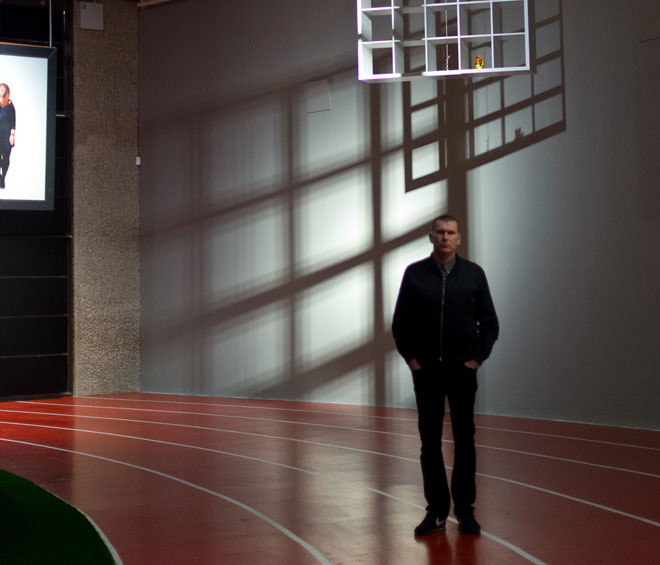
Barbican Curve Gallery, London
29 September 2016 – 8 January 2017
by VERONICA SIMPSON
The Barbican’s Curve gallery is a 90-metre long lofty tunnel of a space, notoriously difficult to programme. But Welsh artist Bedwyr Williams (b1974) likes difficult spaces – or, let’s say, he prefers unorthodox environments to the usual “white cube” gallery. And he has not disappointed with his first solo outing at the Barbican. This mischievous, multimedia artist has decided to play tricks on us all, creating a sequence of theatrically staged experiences whose content delivers the kind of unexpected twists and turns that are typical of Williams’s work, taking you on a surreal journey into the inner workings of his fecund imagination.
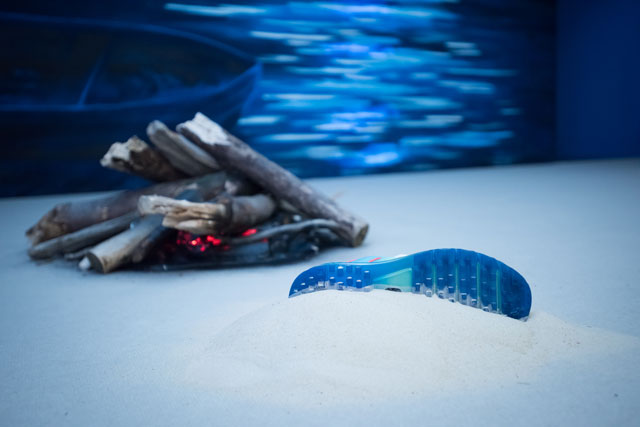
Bedwyr Williams: The Gulch, The Curve, Barbican Centre, London. Photograph: Max Colson.
The rhythmic sound of swooshing waves entices you into the gallery and past two large and very artificial-looking sand dunes, topped with tall grasses, delivering you into a moonlit beach scene rendered with just enough skill to be convincing, but not so much as to detract from its broad-brushstrokes theatricality. There is midnight-blue paint on the walls, and a roughly rendered light-box sea ripples with moonlight shimmer from a cartoon full moon painted above it. A crackling fake bonfire completes this pseudo-idyllic beach setting, while from a nearby discarded trainer, gently glowing by the fire, we hear the soft but insistent tones of a female voice singing a Welsh folksong. The curious and the kitsch combine to create Williams’s off-kilter world.
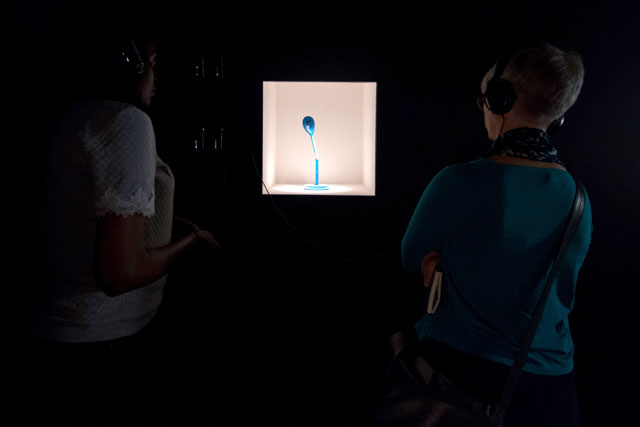
Bedwyr Williams: The Gulch, The Curve, Barbican Centre, London. Photograph: Ben Pruchnie/Getty Images.
Around the next corner is a dark corridor, containing a series of brightly lit vitrines. One features a blue-painted wooden spoon bearing the number five, with its stem snapped and roughly repaired with yellowing sticky tape. This, you might guess, is no ordinary spoon. Adjacent headphones reveal its astonishing fictional history: it is the only surviving item from a restaurant built in the shape of “a boob”. A cheery, family- and pet-friendly cafe by day, by night it would turn into a semi-satanic place of debauchery, filled with hell-bent foodie hedonists, who would break these inoffensive numbered spoons, or subject them to an unpleasant form of cutlery waterboarding in the urinals. The restaurant and its contents – furniture, staff, and guests – were ultimately blown to smithereens on a fancy dress night when the manager’s hat (a papier-mache bomb) was secretly filled with gunpowder by his staff, in a “prank that went wrong”. The spoon survived only because some joker had placed it outside on the roof of a waiting minicab just minutes before the bomb exploded. The rollercoaster ride of the spoon’s biography is related by Williams in a deliciously deadpan style, reminiscent of John Cale’s surreal Welsh-accented monologue The Gift - undoubtedly the oddest track on the seminal Velvet Underground album White Light/White Heat.
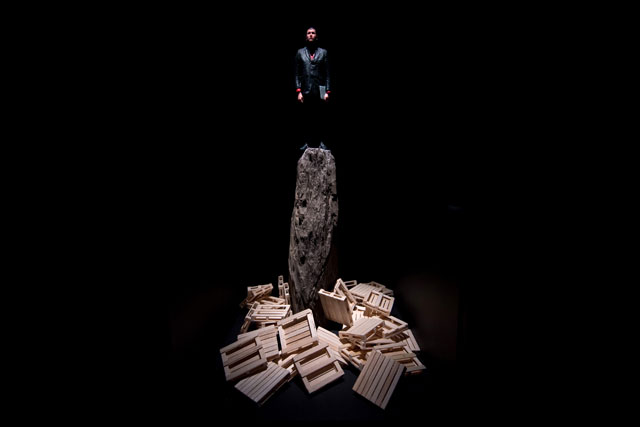
Bedwyr Williams: The Gulch, The Curve, Barbican Centre, London. Photograph: Ben Pruchnie/Getty Images.
But other vitrines provide no such soundtrack or clarification. One offers up a tiny plastic model of Williams in a suit, on top of a tall, thin rock, with a multitude of miniature wooden palettes cast up around its base. Opposite, a low-slung large showcase features a dozen black wigs pooled, at knee height, on the floor of the case, along with a few large rocks. Another offers a round, moon-like, lit glass lamp. In the adjacent vitrine, a headless and knickerless mannequin slowly rotates, wearing a branded baseball jacket clearly created for this show. Its back bears appliquéd letters spelling out “The Gulch”, with a goat’s head underneath, and the caption “Ruminate”. Its front is adorned with a metal goat badge, a beer-bottle top and an appliquéd pair of bongo drums. These drums pop up in three-dimensional form in the next section: a beanbag-filled crash pad for music-making. Various African drums sit expectantly in the gloom, while a (working?) vending machine offers refreshments. Williams wants his visitors to get stuck in and participate – though none of those present when I visited had the nerve.
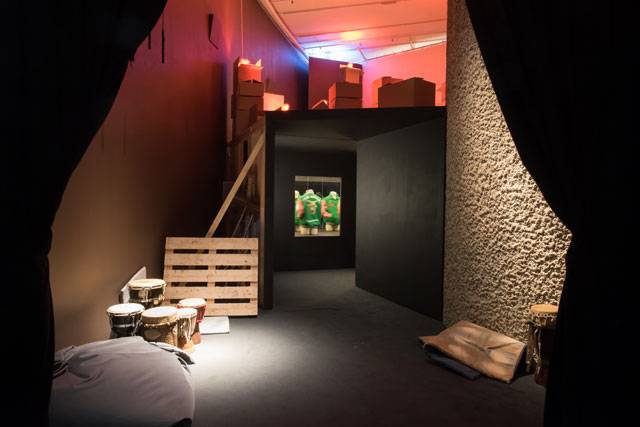
Bedwyr Williams: The Gulch, The Curve, Barbican Centre, London. Photograph: Max Colson.
Williams’s spaces have an eerie quality of suspended animation – either waiting for our arrival, or freshly vacated, or both. The room beyond the drums is a case in point: an immaculately polished boardroom table is surrounded by expensive corporate swivel chairs, while a screen shows Williams’s film piece Flexure – the main meal of the show, as it were. Commissioned for the 2016 Barnaby Festival in Macclesfield, it deals with a depressed hypnotherapist struggling to cope with the noise that travels down his chimney flue from a nuisance neighbour; the hoarse, sweary interjections are interfering with his patient consultations. In trying to tackle this noise pollution issue, the hypnotherapist goes on a bizarre journey of self-discovery that involves the solitary completion of thousand-piece jigsaws, lingering visits to run-down small-town shopping malls, encounters with hypermobile hippy yoga teachers and acoustic dampening experiments. These disjointed elements are collaged in a psychedelic mix of animation, photography, film and rudimentary graphics, underpinned by Williams’s mellifluous voiceover, which channels the bland, pseudo-American monotones of a classic hypnotherapy CD.
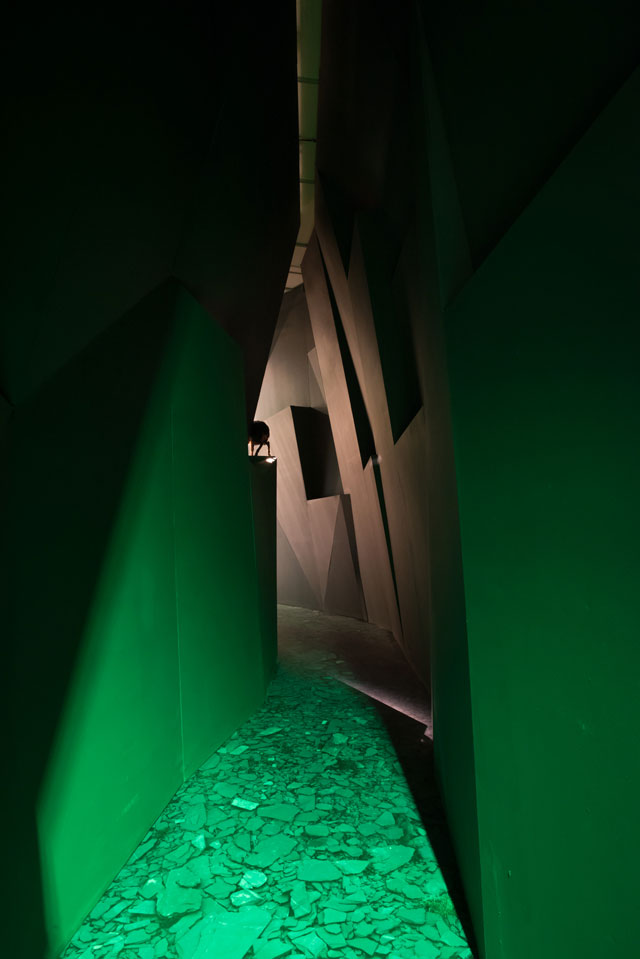
Bedwyr Williams: The Gulch, The Curve, Barbican Centre, London. Photograph: Max Colson.
After the affluent cocoon of the black boardroom, we are thrust into a gloomy, green-lit gulley that cuts in over our heads. We are forced to walk below a stuffed goat standing on a ledge, which stares balefully ahead out of glassy, marble eyes, waiting to be provoked – like some hairy heckler – by anyone brave enough to stroll up and speak or sing into the nearby solitary, spotlit microphone, and in so doing, triggering the goat’s interjections.
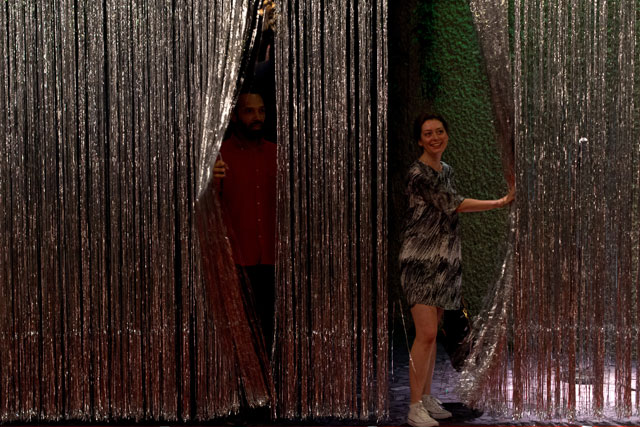
Bedwyr Williams in The Gulch, The Curve, Barbican Centre.
Photograph: Ben Pruchnie/Getty Images.
Next to the microphone is a swishy silver curtain, of the kind that any working-man’s club might put up on cabaret night to symbolise a certain kind of makeshift glamour; a perfect karaoke stage set, but without any autocue. And if you push through the silver strands, you find yourself on a red athletics track, its lanes marked out in white tape, which stretches up the ramp to the exit doors. The only inhabitants of this final set are a gormlessly gurning cast of gold waving-cat figurines that symbolise prosperity, placed on a number of white Ikea shelving units that have been suspended from the ceiling, their shadowy grids (and inhabitants) spookily projected on to the walls. There are two more crucial elements: another discarded trainer, larger than the first, out of which a soft male voice projects, crooning the tenor part of the aforementioned Welsh folk song; and a large poster over the exit doors, showing a two-dimensional group of pals holding a three-dimensional ghetto blaster.
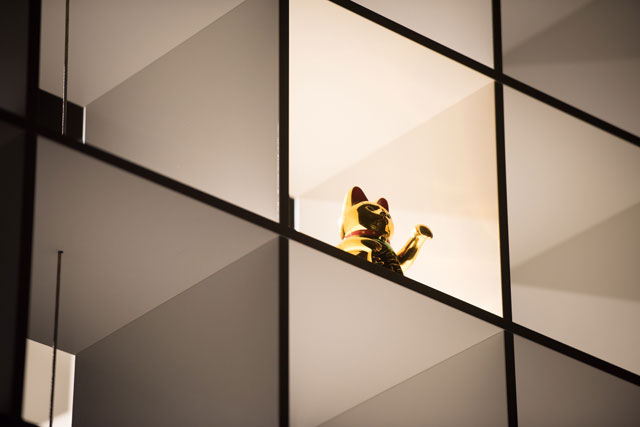
Bedwyr Williams: The Gulch, The Curve, Barbican Centre, London. Photograph: Max Colson.
What Williams excels at is the layering of unlikely encounters, objects and experiences to create a whole range of responses – bafflement, curiosity, repulsion, wonder, hilarity. His work has been described as “relational”, and his experiential non-sequiturs are designed to celebrate that which is not normally celebrated by the art world – the banal landscapes of everyday life, moments of social awkwardness, eccentricity, naffness, amateur obsessiveness, things that have fallen from favour and fashion – and mine them rigorously for humour and empathy. His skill is all in the detail: he is a genius at finding the right verbal or visual cues that place you, the viewer, in a particular social, cultural or emotional context, and then disrupting the narrative in ways that provoke laughter, discomfort or a sly grin of recognition. He plays on our collective sensibilities like a particularly wayward, mood-setting maestro and, by doing so, reveals the connective tissue of shared experience, however unglamorous.
The beauty of the banal is rich material for Williams. In conversation a few days after the opening, he reveals that his inspiration for this disconnected sequence of everyday tableaux is global furniture megastore Ikea. “Not the marketplace section,” he asserts, but that section where aspirational living rooms, kitchens and bedrooms are set up, and in which people are enticed to “play house”. Williams says: “When you go through Ikea and you see people self-consciously trying the bed, bouncing on chairs, I find that quite an interesting experience.”
At the Barbican, Williams worked closely with curator Lotte Johnson to fine-tune the thresholds and connections in this surreal spatial procession, highlighting that sense of “wondering about the people before you and behind you: who has just come through, and who you’re in the wake of,” explains Johnson.
The acoustic and interactive elements are designed to enhance that sense of being haunted by your own journey, or the journeys of your predecessors or followers. They harness both the natural acoustic properties of the space (shaped like a horn, sounds resonate along its length in both directions) and those acoustic “gags” he has set up. In this way, the singing trainer percolates through the bongo room and both soundtracks trickle into the background of the boardroom film show. Any spontaneous karaoke or cabaret performance into the mic triggers a response from the goat behind you. And recordings of the most recent bongo performance are also relayed to the ghetto blaster that hangs over the exit. “You’re kind of speaking to your future self through the exhibition,” says Johnson.
This idea of messing with timing and people’s sense of sequential logic is an enduring fascination for Williams – he loves to play with what he calls the “pregnant punchline”; the joke you don’t see coming. He gives an example: “In Porthmadog in North Wales, there’s a cob (sea wall) that you drive over to cross the estuary and it used to be a 20p charge to cross and you would just throw it in the guy’s bucket and drive over. There was this well-known character who went over the cob once and threw in 40p and said: ‘It’s for me and the guy behind.’ He didn’t know who the guy behind was. It was just a generous gesture. I love the idea of the guy who came after, who was told: ‘There’s no charge, he has paid for you.’ He’d be thinking: ‘What? Who the hell? And why? I love that kind of humour … like a friend of mine who had hired a van once, and was in a traffic jam. He was hitting the steering boss in the centre and it came off in his hands. And there was a note underneath saying: ‘Put it back.’ It’s such a great joke. It’s like a message in a bottle. So the drums are like that in some way.”
There may be gags aplenty, but there is nothing glib about Williams’s installations. Even the more baffling items are underpinned by a heartfelt strand of enquiry or provocation. The balloon lamp is a genuine relic from the local Methodist chapel that Williams used to be dragged to by his devout parents every Sunday. He snapped it up when he saw the set being chucked out during a recent refurbishment. He treasures it because, when he was a kid, he would look up at this mysteriously glowing lamp and think that the holy spirit was in it. Its place in the sequence of vitrines is, however, purely intended to evoke such objects of mystery. That whole section is a homage to the kind of dusty, dimly lit museum of yore, where objects behind glass maintained some kind of special unworldly significance thanks to their lack of context. Williams says: “I think museums have been a little bit ruined in the late 80s and 90s when they tried to make them fun. The whole thing about them was that they were unknowable and slightly over your head.”
The miniature Bedwyr on a rock turns out to be an accolade to the supermarket chain Asda’s most unusual customer service. Williams says: “There are five Asdas in the UK that offer this service, called 3D Me. You stand in a booth and a trammel spins around you and you get a 3D version of you.” The rock is from his garden; the wooden palettes were inspired by one of his frequent trawls through eBay, a tribute to the amateur craftsman whom he found fashioning miniature wooden palettes that serve no purpose. He usually sells them in packs of five. “I was his dream commission,” says Williams. Ebay, for Williams, is like a fantastic “open source notebook”.
The wigs are slightly more random, he concedes, clarifying with a line that he apparently often uses in his talks to art students: “Sometimes I make things and I can’t tell you why. It’s good to be honest.” But they were prompted by a horrified fascination with earthquake survivor pictures of rubble on people’s heads, and a whim to disconcert with the unusual knee-level viewpoint.
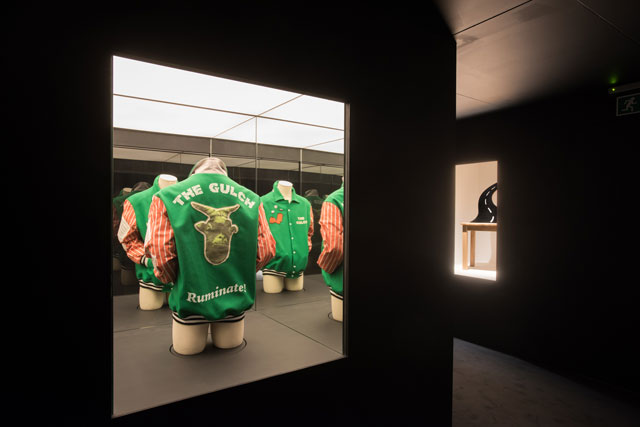
Bedwyr Williams: The Gulch, The Curve, Barbican Centre, London. Photograph: Max Colson.
The varsity jacket represents a private joke about artists as “bloody know-alls” – especially London artists. “The thing about the varsity jacket is that they’re designed to make unremarkable men seem bigger, with the puffed up sleeves and the blouson effect.” Its presence is a protest against unwarranted cockiness. “For me, living in the sticks, I find London artists unbearable: their self-belief and lack of humility.”
The song that emerges from each trainer is also a carefully crafted element in the show’s labyrinth of associations: it is a Welsh song, whose title Williams translates as “While There are Two”. He says: “That’s a joke about shoes, too, obviously. But it’s a song that considers all the things that you would value in life, and says all of these things are nothing compared to just the fact of being one of two. lt’s quite a beautiful song.” The two folk singers recorded are known to Williams, and will be performing in the Curve Gallery while the show is on. There are many such interactive, audience-engagement opportunities lined up, including a yoga class featuring the very same hippy yoga teacher who appears in the film, and a Welsh school disco.
Willams, who is arguably Wales’s most successful contemporary artist – he represented Wales at the Venice Biennale in 2005 and again in 2013, and has just been shortlisted for an Artes Mundi prize – has made no bones about his lack of love for the more pretentious, preening side of the art world. He wanted to make The Gulch an accessible, enjoyable show, “especially as this is a free space in the Barbican. If I was making oblique statements, and you would have to know my practice to get it, that would be a really ungenerous thing to do.” However, he is aware that there may be criticisms of this approach. And he makes sure he gets the last laugh. “I thought about people that wouldn’t like my show … they might think this work is so obvious and on a plate, there’s no subtlety, it’s not explained. Then they get pushed through a glitter curtain and they’re on a running track …” And now we see the hidden punchline: he is fast-tracking his critics out through the exit.